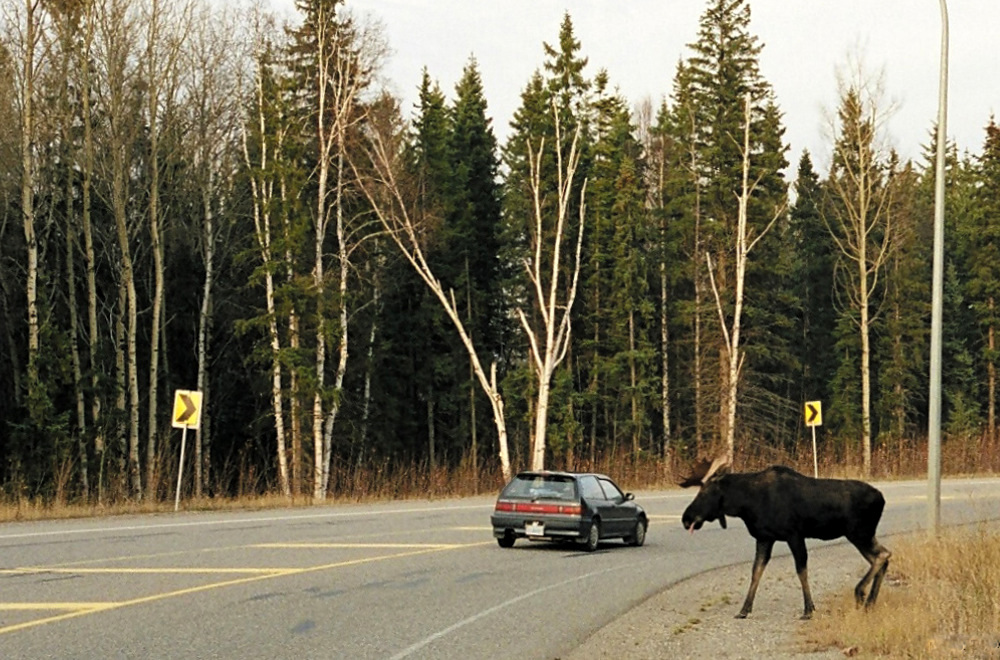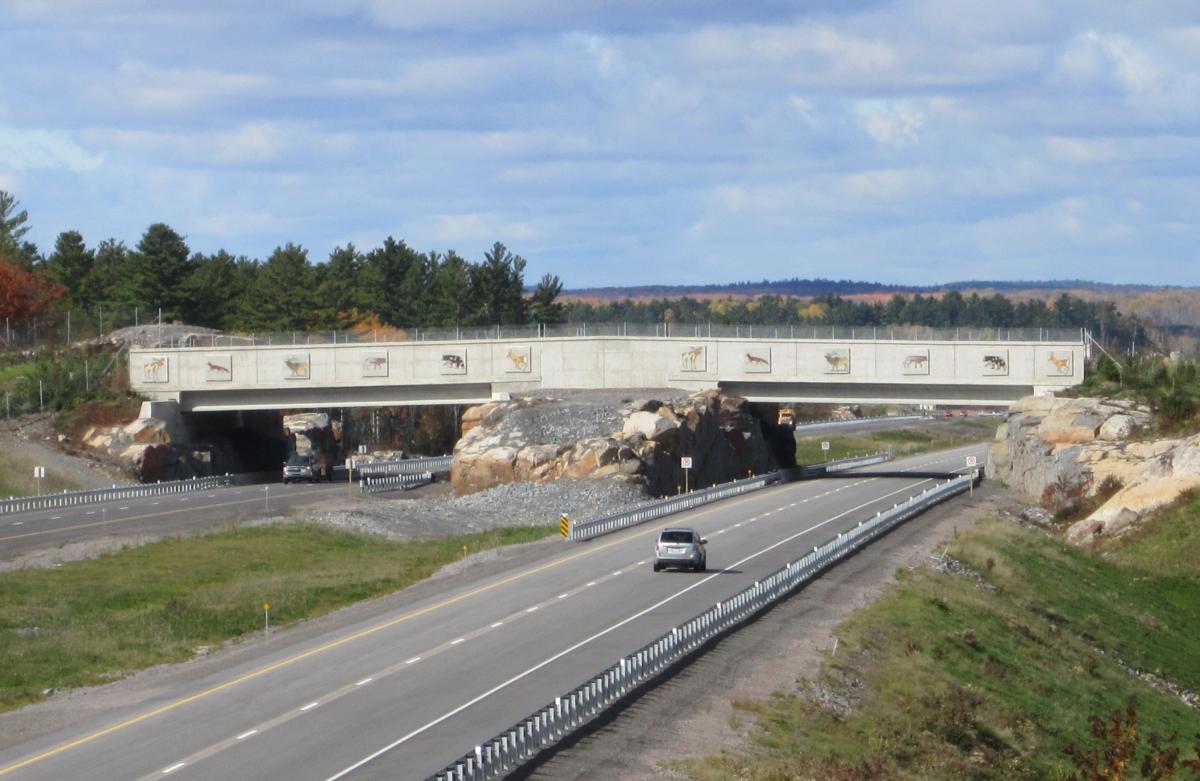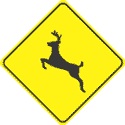
Important driving tips as peak season approaches
Fall brings beautiful autumn colours and more wildlife onto Ontario’s roads – and a need for drivers to be extra vigilant.
The number of animal strikes on Ontario roads in 2019 was 12,367, including 348 injuries, according to the Ontario Road Safety Annual Report. About half of all fatal crashes happen on rural roads, where speed limits are faster -- stay alert and scan the road ahead for domestic, farm, or wild animals
October to January is a peak time for vehicle collisions with wildlife, and autumn is the most dangerous time. Collisions with wild animals like moose or deer can result in serious vehicle damage, personal injury, or even death.
Employees at high risk
For Ontario workers, motor vehicle incidents account for more than 38 percent of all worker traumatic fatalities, including wildlife collisions. Driving is one of the highest risk activities an employee can undertake. Unlike a worksite, employers cannot control the types of drivers and vehicles that share the road with their employees.
If employers have workers driving from site to site, travelling to a meeting, or even going out on a coffee run, the Workplace Safety and Insurance Board considers them to be occupational drivers. Between 2006 and 2010, the board reported more than 7,000 lost-time injury claims and 149 fatalities involving occupational driving.
Did you know?
-
On average, there is a motor vehicle-wild animal collision every 38 minutes
-
One out of every 17 motor vehicle collisions involves a wild animal
-
Motor vehicle-wild animal collisions are increasing annually. In 2014, 13, 152 collisions were reported. Many more go unreported.
-
89 percent occur on two-lane roads outside of urban areas
-
86 percent occur in good weather
-
Wild animals are unpredictable at all times, however, there are two peak times when the risk of a collision is highest: May and June and from October to January.
If you could talk to the animals
Frequently asked questions about animal behaviour
What should drivers know about wildlife behaviour in order to anticipate hazards?
Animal behaviour is related to the “fight-or-flight response.” There is a certain amount of space in which an animal feels safe; but once that boundary is violated, the animal’s reaction is unpredictable. Even if an animal sees you, it may still jump in front of your vehicle. Some animals travel together, for example deer, bears, and mother-offspring pairs. If one animal crosses the road, others may follow. If an animal has crossed the road, it may turn and cross again. Animals standing calmly at the side of the road may bolt unexpectedly.
Why do deer swerve in front of the vehicle?
In an attempt to avoid predators, deer run in a twisting or dodging motion. That is why deer may make a sudden swerve right in front of a vehicle – that is how they are “programmed” to respond to a threat.
Is wildlife attracted to the road?
Humans know that the road can be a dangerous place, but wildlife may actually be attracted to its wide open spaces. Roadside forage and road salt attracts wildlife. In the winter, ploughed roads offer easier movement. In the summer, increased wind provides relief from biting insects.
Wildlife Bridge
To reduce the risk of collision, Ontario developed the province’s first wildlife overpass. The structure was built as part of the expansion of Highway 69 between Parry Sound and Sudbury, in an area where collisions with large animals, including white-tailed deer, moose, elk and black bears, are common. Fencing along the highway guides the animals towards the overpass. For cost-effectiveness, designers took advantage of existing landscape features. Similar overpasses have been built in Banff National Park, the United States and Europe. There are also plans to install wildlife crossings under Highway 69.
Photo courtesy of MTO
Wildlife Detection System
In 2010, a “break the beam” wildlife detection system was installed on Highway 17 near Sault Ste. Marie. When an animal crosses in front of the beam, a flashing light on the wildlife sign is activated, signalling motorists that animals are nearby. When the lights flash, drivers reduce speed and become more alert to movement along each side of the roadway. The preliminary findings of this new technology are very promising: in the five years preceding installation, there were 11 reported wildlife collisions; however, in the first two years of the system’s installation, there has only been one reported collision.
Photo courtesy of MTO
How you can reduce your risk of collision with wildlife
Hopefully, you’ve never experienced that heart-stopping moment when a deer suddenly leaps in front of your vehicle, but if it ever does, what do you do? Here are suggestions from the Wildlife Collision Prevention Program.
1. Watch for the signs
What do those signs really mean?
A Wildlife Warning Sign is a yellow diamond shaped sign. The sign warns of a hazard ahead, and advises drivers to be cautious. The sign does not require you to slow down, unless there is an adjacent speed limit sign posted as well.
Drivers must obey wildlife warning signs and any associated speed changes. The signs are located in high wildlife use areas. When you drive by these signs every day, it’s easy to become complacent. So, remind yourself they are there for a reason – and remain alert.
2. Reduce speed
Speed is one of the most common factors in vehicle collisions
Experienced drivers know that if you’re going too fast, your ability to react and steer away from objects on the road is severely compromised. Speeding also means you need to cover more distance to come to a full stop and, in the event of a collision, greatly increases the force of impact.
When road conditions are good, there’s also a tendency to want to speed up. Take your time getting to your destination, set your cruise control for the posted speed, and that way you’ll compensate for the increased risk. Some studies suggest that wildlife vehicle collisions occur more often on long straight stretches, dry road conditions, and clear nights – when vision is good and drivers may be speeding. Drivers tend to be more cautious on curving roads and in poor weather.
3. Think: “What if...?”
Mental preparation a useful tool
Think about and predict what you might do if an animal suddenly darted out in front of you or ran towards your vehicle. It’s better to mentally rehearse how you might avoid an encounter with wildlife, than have to react to a dangerous situation when you’re unprepared.
4. Drive defensively
What to look for
Drivers and passengers should actively watch for wildlife - on the road, in the ditch, on the shoulder, and in the right of way; watch for any movement along the sides of the road. Shining eyes mean your headlights are reflecting off the animal’s eyes, however it’s important to note that moose are so tall that their eyes are normally above the beams of most vehicle headlights, and so are less likely to reflect the light.
If you notice flickering in the headlights of oncoming cars or in the tail lights of the vehicles in front of you, it could be an animal crossing the road. Roadside reflectors that suddenly disappear or reappear may indicate an animal crossing in front of them. Watch out between dusk and dawn: light levels are low, and animals are active.
Anecdotally, there seems to be some evidence that animals that approach from the right side are avoided more successfully than animals that approach from the left, as vehicle headlights illuminate that portion of the road better, and drivers pay close attention to the right hand side of the road and the ditch – so remember to pay equal attention to both the right and left hand sides of the road.
Think about the landscape that you are driving through. Is it good habitat for wildlife? Studies show problem locations include creeks that intersect with roads, good roadside habitat nearby, and long straight stretches where drivers tend to speed.
5. Steer clear
To swerve or not to swerve?
If smaller animals such as deer are in your way – think carefully – is it safe to swerve? Do not take unsafe evasive actions. Serious incidents can occur when drivers lose control of their vehicles trying to avoid an animal. Always reduce your speed in signed areas. Driving at a slower speed may mean it is not necessary to swerve at all. Swerving can take you into the path of an oncoming vehicle or into the ditch.
If a deer is in your way, consider using your brakes, not your wheel. If you have to choose between swerving or striking a moose, consider swerving. A collision with a moose, which can weigh up to 500 kgs (1200 lbs), carries a significant risk of injury or death to motorists and passengers. If a crash with a moose is inevitable, crouch as low as possible in your seat, or under the dash, as a moose's body usually ends up crushing the roof of a car completely flat.
6. Make the most of your vehicle
Basic maintenance of lights and windshield important
It’s important to maintain your vehicle and keep headlights, signal lights, and tail lights clean and in good working order. Regularly clean your windshield inside and out, and check and repair windshield wiper blades. Keep headlights properly aligned to avoid blinding other drivers and optimize road illumination. Check the condition of the headlight lenses in the spring and fall and clean, repair or replace if they are cloudy or scratched.
Wear your seatbelt at all times. Honk your horn or flash your lights to scare animals off the road – this may scare a deer off the road, but does not usually work for moose. In a three-lane situation, if safe to do so and not impeding other traffic, drive in the middle lane to provide more distance from the ditch.
Use high beams when it is safe to do so, and scan the road ahead with quick glances. At night, the high beams of the vehicle in front of you can extend your effective sight distance. Install enhanced headlights to extend your effective sight distance – but do not exceed federal guidelines. Investigate an “Electronic Stability Control” system for your vehicle.
Illustration: Wildlife Collision Prevention Program
Electronic Stability Control
Electronic Stability Control (ESC) helps you maintain control of your vehicle in emergency avoidance manoeuvres such as swerving around wildlife. ESC detects and corrects loss of vehicle control, according to the Wildlife Collision Prevention Program. If you skid, ESC works together with your antilock braking system and automatically applies braking to the correct wheel to help you regain control. ESC reacts instantly, often correcting your direction before you know you are skidding.
The Insurance Institute of Highway Safety (IIHS) released a statement on June 13, 2006 that ESC reduces the risk of:
-
All single vehicle crashes by more than 40 percent;
-
Fatal single vehicle rollovers of SUVs by 80 percent;
-
Fatal single vehicle rollovers of cars by 77 percent; and
-
All types of fatal crashes by 43 percent.
Many experts worldwide describe ESC as “the most important auto safety innovation since seat belts.” Check out Electronic Stability Control the next time you buy a new vehicle. As of September 1, 2011, Canada requires all new passenger vehicles (trucks, cars, and vans up to 10,000 lbs) to have Electronic Stability Control.
What if a crash is inevitable?
In certain conditions, there is no real choice except to strike the animal
If it appears impossible to avoid the animal, aim for the spot the animal is coming from, not where it is going. Look where you want to go, not at the animal. You tend to drive where you look – if you are looking at the animal, that is where the vehicle tends to go.
If you must hit something, try for a glancing blow rather than a head-on hit. Brake firmly and quickly, then look, and steer your vehicle to strike the animal at an angle. Let up on the brake just before you hit the animal. This causes the front end of your vehicle to rise and reduces the chances of the animal coming through your windshield.
What should you do if you have a collision with wildlife?
Your reaction to the collision is dependent on the type and condition of the road, the amount of traffic, the type of animal, and the condition of the driver. First, pull off the road in such a way as to illuminate the animal with your headlights and turn on your hazard lights.
You may choose to carefully approach the animal to determine if it is dead or injured. If it is injured, back off. A wounded animal can be very dangerous. You are not required to put an injured animal out of its misery. You may choose to remove a dead animal from the road so that it does not present a hazard to other drivers.
Only remove the animal if it is safe to do so, and you are physically capable of doing so. Inspect your vehicle to see if it safe to continue driving. Call 911 if there is damage over $1000 or any human injuries. Call the local police or a Ministry of Natural Resources office.
Even if your vehicle is not damaged, reporting the exact location helps officials monitor injured animals and recover dead ones. Quick removal prevents other animals from being attracted to the highway.
Help educate your colleagues – forward or tweet this article
So, when you’re driving the highways this fall, admiring the glorious foliage of our beautiful landscape, keep an eye out for our furry friends. Be sure to help educate friends, family, and colleagues – especially new and younger drivers – to the dangers of collisions with wildlife, and enjoy safe travels!
Resources
Road to Safety - Implementing a Safe Driving Program
Wildlife Collision Prevention Program
MTO Driver Handbook
Ministry of Natural Resources – Ontario office locations



